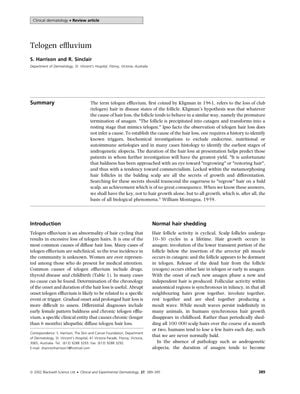Telogen Effluvium: Causes, Diagnosis, and Treatment
July 2002
in “
Clinical and Experimental Dermatology
”

TLDR Telogen effluvium is a common type of hair loss that can resolve on its own or become chronic, with treatment depending on early diagnosis.
In 2002, Harrison and Sinclair described telogen effluvium as a prevalent cause of diffuse hair loss, particularly affecting women, with acute cases often resolving spontaneously and chronic cases persisting for over 6 months. The condition is characterized by excessive shedding of telogen hairs, with common triggers including drugs, thyroid disease, and childbirth, although sometimes no cause is identified. Diagnosis is based on patient history, clinical examination, and sometimes scalp biopsy, which helps differentiate chronic telogen effluvium from androgenetic alopecia by showing a normal anagen:telogen ratio without follicle miniaturization. While acute telogen effluvium is usually temporary, chronic telogen effluvium's course is less clear, and some cases may later be reclassified as androgenetic alopecia. Treatment approaches vary, with early diagnosis crucial for managing androgenetic alopecia effectively.
















